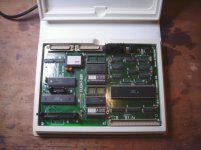Stephen Scutt
Member
- Joined
- Sep 9, 2015
- Messages
- 22

Hi all. As well as acquiring a Micro Professor Z80 trainer recently, I also got a Flight 68K trainer board. It is the issue shown in the picture.
I'm not sure how to connect it up to anything to get it working.
Also, there is scant information on this particular issue on the web.
Please would anyone know what I would need to use this board? I see it has parallel ports whereas the models I see on the web have serial type ports...
If anyone knows of a link to the manual in PDF I would also be grateful.
Thanks,
Steve.S.:D
